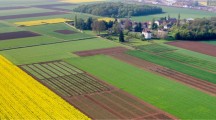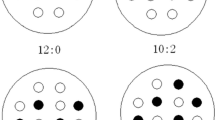Abstract
The N nutrition index (NNI, defined as the actual shoot N concentration relative to a reference critical value, Nref) is a valuable tool to analyze the N nutrition status of crops. We present empirical evidence obtained for a range of forage grass species and environmental conditions with the aim to contribute to verify the NNI as a tool to diagnose N deficiency and to examine responses to N fertilization. Ten N fertilization experiments were conducted in the SE of the Pampa region (Argentina) and included (1) perennial (Festuca arundinacea Schreb. Thinoppyron ponticum (Podp.) Barkworth and Dewey) and annual (Lolium multiflorum Lam., Avena sativa L. Bromus catharticus H.B.K.) grasses, (2) autumn, winter and spring regrowths, and (3) good and poor quality soils. Experiments comprised four to six N fertilization rates, each including five to seven sequential harvest dates. Plots were replicated in three or four complete randomized blocks. All experiments were rainfed and adequately provided with phosphorus. The critical N concentration (Ncr) -that is the minimum plant N concentration required to reach maximal accumulated shoot biomass- was determined for each harvest date. Observed Ncr were then compared to values predicted by the general reference curve (Nref) proposed elsewhere. In six of the ten experiments measured Ncr agreed with predicted Nref. Thus, the present study extends to marginal soils, to species adapted to such environment, and to winter growth conditions the empirical support for the use of Nref in the quantification of pasture N deficiency. But Ncr was lower than Nref in four experiments in which growth conditions were not adequate for reaching potential growth rates. Therefore, it is suggested that when factors other than N are expected to limit pasture growth, an Ncr lower than Nref should be considered. In all experiments, a direct relationship between accumulated shoot biomass and NNI was found, radiation use efficiency (RUE) being more negatively affected than photosinthetically active radiation interception (PARi) by N deficiency. Reductions in the latter were relevant only from moderate to severe N deficiency. Notably, the NNI achieved at initial stages of regrowth (150-200°C day after the fertilization date) was highly associated with the N nutritional status along the regrowth and, therefore, confirming NNI as a promising tool for diagnostic purposes.








Similar content being viewed by others
References
Agnusdei MG, Colabelli ME, Fernández Grecco RC (2001) Crecimiento estacional de forraje de pasturas y pastizales naturales para el sudeste bonaerense. Boletín Técnico N°152. CERBAS, INTA EEA Balcarce, 16 p
Barbieri PA, Echeverría HE, Sainz Rozas HR, Picone L (2006) Nitrogen use efficiency from urea applied to a tall wheatgrass (Elytrigia elongata) praire in a sodic soil. Aust J Exp Agr 46:535–543
Bélanger G, Richards JR (1997) Growth analysis of timothy grown with varying N nutrition. Can J Plant Sci 77:373–380
Bélanger G, Ziadi N (2008) Phosphorus and nitrogen relationships during spring growth of an aging Timothy Sward. Agron J 100:1757–1762
Bélanger G, Gastal F, Lemaire G (1992) Growth analysis of a tall fescue sward fertilized with different rates of nitrogen. Crop Sci 32:1371–1376
Bélanger G, Walsh JR, Richards JE, Milburn PH, Ziadi N (2001) Critical nitrogen curve and nitrogen nutrition index for potato in Eastern Canada. Amer J Pot Res 78:355–364
Bélanger G, Tremblay GF, Mongrain D (2008) Yield and nutritive value of the spring growth of an ageing Thimothy Sward. Can J Plant Sci 88:457–464
Borrajo CI (1998) Generación y expansión de los órganos foliares de agropiro alargado en función del material genético y la disponibilidad de nitrógeno. Thesis M Sc, Universidad Nacional de Mar del Plata
Buol SW, Hole FD, McCracken RJ (1989) Soil genesis and classification, 3rd edn. Iowa University Press, Ames, p 446
de Prado MR, Echeverría HE, Lattanzi FA, San Marín NF (2001) Evolución otoño invernal del nitrógeno mineral en un natracuol típico bajo festucas con diferente hábito de crecimiento Ciencia del Suelo. 19:39–46
Duru M, Ducrocq H (1996) A nitrogen and phosphorus herbage nutrient index as a tool for assessing the effect of N and P supply on the dry matter yield of permanent pastures. Nutr Cycl Agroecosyst 47:59–69
Duru M, Lemaire G, Cruz P (1997) The nitrogen requirements of grasslands. In: Lemaire G (ed) Diagnosis on nitrogen status in crops. Springer, Berlin, p 59
Echeverría HE, García FO (1998) Guía para la fertilización fosfatada de trigo, maíz, girasol y soja. Boletín técnico 149. Estación Experimental Agropecuaria INTA Balcarce, 18 p
Falster DS, Warton DI, Wright IJ (2006) SMATR: Standardised major axis tests and routines, ver 2.0. http://www.bio.mq.edu.au/ecology/SMATR/. Cited 9 Oct 2009
García FO (2001) Balance de fósforo en los suelos de la región pampeana. INPOFOS Cono Sur. Informaciones Agronómicas del Cono Sur 9:1–3
García FO (2003) Introducción. Simposio “El fósforo en la agricultura argentina”. INPOFOS Cono Sur, Instituto de la Potasa y el Fósforo, Potash & Phosphate Institute, Canada, pp 2–3
Gastal F, Lemaire G (2002) N uptake and distribution in crops: an agronomical and ecophysiological perspective. J Exp Bot 53:789–799
Gastal F, Bélanger G, Lemaire G (1992) A model of the leaf extension rate of tall fescue in response to nitrogen and temperature. Ann Bot 70:437–442
Gosse G, Varlet-Grancher C, Bonhomme R, Chartier M, Allirand JM, Lemaire G (1986) Production maximale de matière sèche et rayonnement solaire intercepté par un couvert végétal. Agronomie 6:47–56
Greenwood DJ, Neeteson JJ, Draycott A (1986) Quantitative relationships for the dependence of growth rate of arable crops to their nitrogen content, dry weight and aerial environment. Plant Soil 91:281–301
Greenwood DJ, Lemaire G, Gosse G, Cruz P, Draycott A, Neeteson JJ (1990) Decline in percentage N of C3 and C4 crops with increasing plant mass. Ann Bot 66:425–436
Greenwood DJ, Gastal F, Lemaire G, Draycott A, Millard P, Neeteson JJ (1991) Growth rate and %N of field grown crops: theory and experiments. Ann Bot 67:181–190
Instituto Nacional de Tecnología Agropecuaria (2009) Información agrometeorológica, datos de la EEA Balcarce. http://www.inta.gov.ar/balcarce/info/meteor.htm. Cited 9 Oct 2009
Justes E, Mary B, Meynard J-M, Machet J-M, Thelier-Huche L (1994) Determination of a critical nitrogen dilution curve for winter wheat crops. Ann Bot 74:397–407
Kuzyakov Y, Friedel JK, Stahr K (2000) Review of mechanisms and quantification of priming effects. Soil Biol Biochem 32:1485–1498
Lattanzi FA (1998) Efecto de la fertilización nitrogenada sobre el crecimiento de festucas de tipo templado y mediterráneo. Thesis M Sc, Universidad Nacional de Mar del Plata
Lemaire G, Agnusdei MG (2000) Leaf tissue turn-over and efficiency of herbage utilization. in: Lemaire G, Hodgson, J, de Moraes A, Nabinger C, Carvalho PC de F (eds) Grassland Ecophysiology and Grazing Ecology. CABI, Oxon, p 265
Lemaire G, Denoix A (1987) Croissance estivale en matière sèche de peuplements de fétuque élevée (Festuca arundinacea Schreb.) et de dactyle (Dactylis glomerata L.) dans l’ouest de la France. II. Interaction entre les niveaux d’alimentation hydrique et de nutrition azotée. Agronomie 7:381–389
Lemaire G, Gastal F (1997) N uptake and distribution in plant canopies. In: Lemaire G (ed) Diagnosis on nitrogen status in crops. Springer, Berlin, p 3
Lemaire G, Salette J (1984) Relation entre dynamique de croissance et dynamique de prélèvement d′azote pour un peuplement de graminées fourragères. I—Etude de l’effet du milieu. Agronomie 4:423–430
Lemaire G, Jeuffroy M-H, Gastal F (2008) Diagnosis tool for plant and crop N status in vegetative stage: theory and practices for crop N management. Eur J Agron 28:614–624
Marino MA (1996) Efecto de la fertilización nitrogenada sobre el crecimiento inverno primaveral, la composición química y calidad del forraje de Avena sativa y Lolium multiflorum Lam. Thesis M Sc, Universidad Nacional de Mar del Plata
Marino MA, Berardo A (2000) Fertilización fosfatada de pasturas en el sudeste bonaerense. II—Efecto de la aplicación de nitrógeno sobre la respuesta a fósforo. Rev Arg Prod Anim 20:113–121
Marino MA, Mazzanti A, Assuero SG, Gastal F, Echeverría HE, Andrade F (2004) Nitrogen dilution curves and nitrogen use efficiency during winter-spring growth of annual ryegrass. Agron J 96:601–607
Mazzanti A, Lemaire G, Gastal F (1994) The effect of nitrogen fertilization upon the herbage production of tall fescue swards continuously grazed by sheep. 1. Herbage growth dynamics. Grass Forage Sci 49:111–120
Moscatelli G, Luters JA, Gómez LA (2009) Niveles de disponibilidad y reservas de potasio en Argentina. International Potash Institute. http://www.ipipotash.org/udocs/Sesion%20l.pdf. Cited 9 Oct 2009
Nelson DW, Sommers LE (1973) Determination of total nitrogen in plant material. Agron J 65:109–112
Plénet D, Cruz P (1997) The nitrogen requirement of major agricultural crops: maize and sorghum. In: Lemaire G (ed) Diagnosis on nitrogen status in crops. Springer, Berlin, p 93
Acknowledgments
The authors would like to thank two anonymous reviewers for comments that greatly improved this manuscript. We received financial and technical support from the Instituto Nacional de Tecnología Agropecuaria (INTA) and the Universidad Nacional de Mar del Plata.
Author information
Authors and Affiliations
Corresponding author
Rights and permissions
About this article
Cite this article
Agnusdei, M.G., Assuero, S.G., Lattanzi, F.A. et al. Critical N concentration can vary with growth conditions in forage grasses: implications for plant N status assessment and N deficiency diagnosis. Nutr Cycl Agroecosyst 88, 215–230 (2010). https://doi.org/10.1007/s10705-010-9348-6
Received:
Accepted:
Published:
Issue Date:
DOI: https://doi.org/10.1007/s10705-010-9348-6




